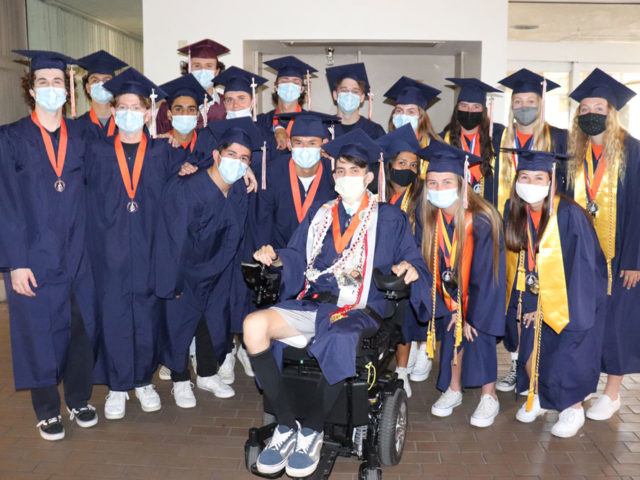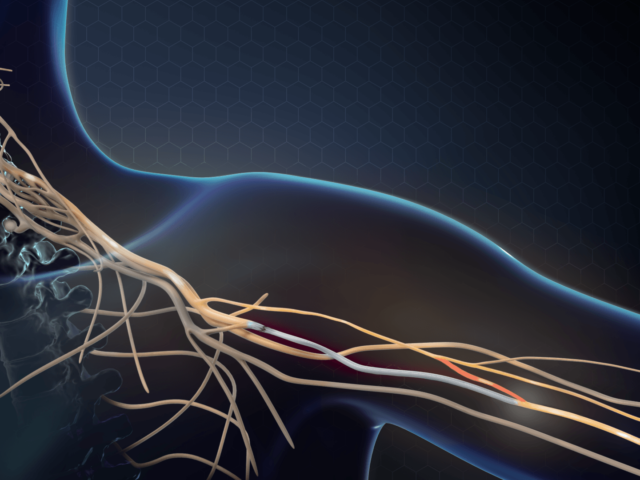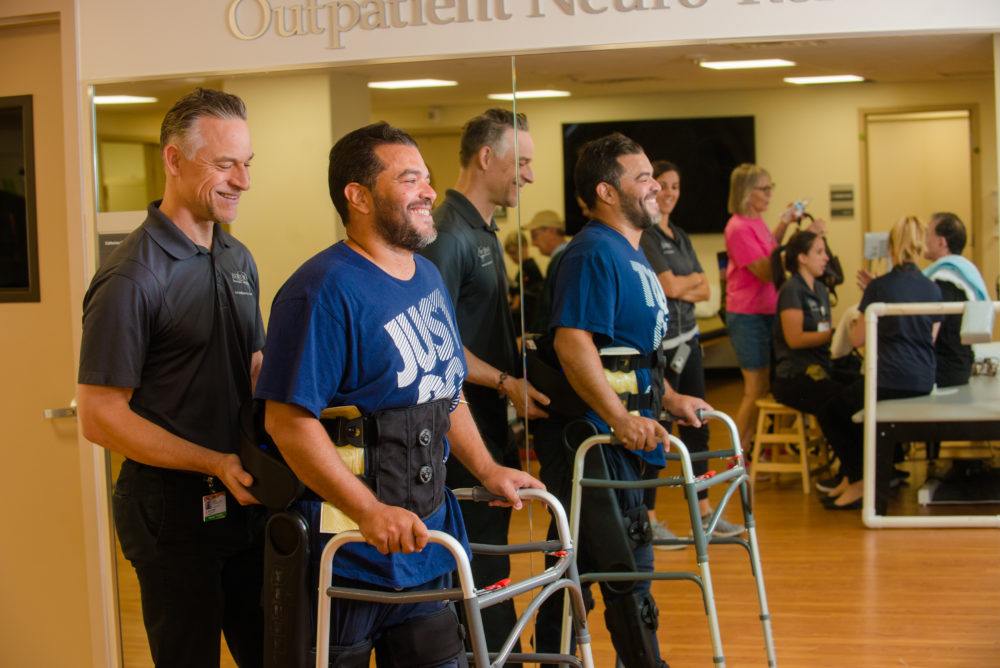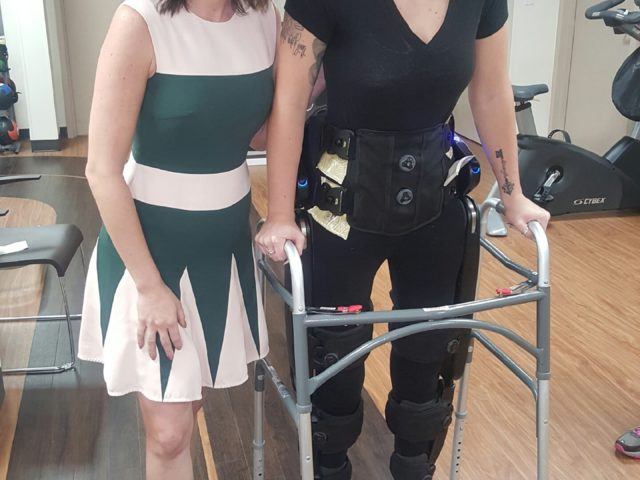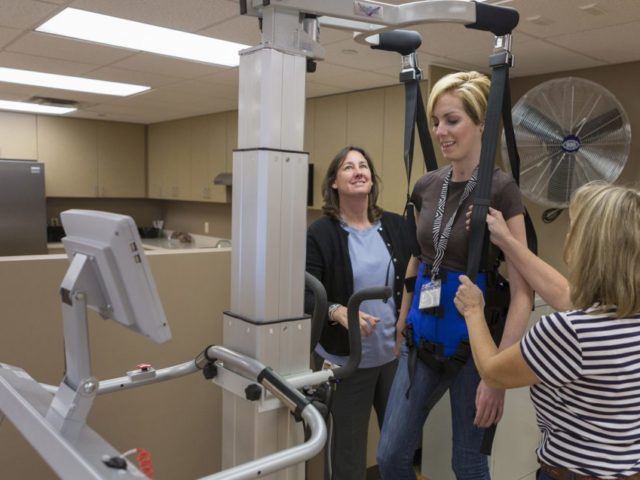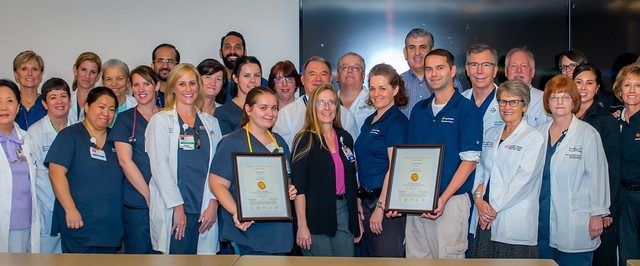
Spinal Cord Injury (SCI)
Spinal Cord Injury Overview
Spinal cord injury (SCI) describes damage to the spinal cord resulting in a loss of ability, such as mobility or sensation.
The spinal cord is a vital part of your nervous system, running down the middle of your back and transmitting signals between your brain and the rest of your body. It’s like the main highway for communication in your body, and damage to it can affect your ability to move, feel, or control certain body parts below the level of the injury. The level of the injury, in this context, describes the part of your spine where the injury occurs.
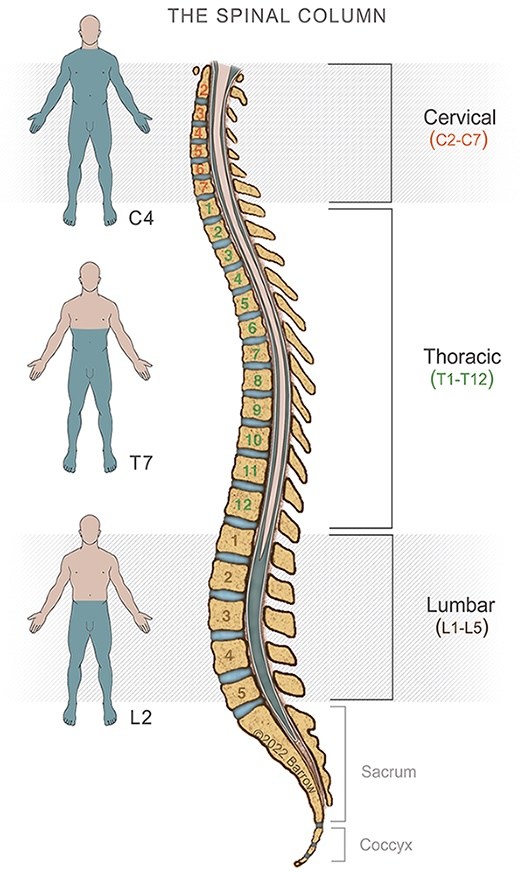
There are different types of spinal cord injuries. Some are complete, meaning there is a total loss of function below the injury. Others are incomplete, meaning there’s still some level of function or feeling below the injury. The specifics of your injury will determine precisely how it affects you.
The cause of spinal cord injuries can vary—trauma from accidents, falls, or sports injuries are common causes, but diseases can play a role too.
After a spinal cord injury, you might experience changes like difficulty moving or feeling sensations, trouble with bowel or bladder control, changes in sexual function, or pain. These changes can be challenging, but it’s important to remember that there are ways to manage them and improve your quality of life.
Diagnosis involves physical exams and imaging tests like MRI or CT scans. Treatment might include emergency care, surgery, medications, and rehabilitation therapies. The goal of treatment and rehabilitation is to help you achieve the highest level of independence and quality of life possible.
Rehabilitation is a vital part of recovery, involving physical medicine and rehabilitation physicians, physical therapists, occupational therapists, and other specialists working with you to strengthen your body, adapt to changes, and learn new ways of doing daily activities.
The road ahead may seem daunting, but you’re not alone. There are resources, support networks, and healthcare professionals dedicated to helping you navigate this journey. Advances in medical research are also ongoing, offering hope for new treatments and improvements in care.
Your resilience, the support of those around you, and the guidance of your medical team will be crucial in adapting to and living with a spinal cord injury.
Causes of Spinal Cord Injury
Spinal cord damage disrupts the signals between your brain and other body parts. The causes of this damage can vary, and understanding them can help tailor your treatment and recovery plan.
Spinal Trauma
Spinal trauma is the most common cause of spinal cord injuries. It can happen in several ways:
- Vehicle crashes: Car, motorcycle, and bicycle crashes are among the leading causes of spinal cord injuries. The impact can damage the spine and spinal cord.
- Falls: Especially in people over 65, falls can result in spinal cord damage. But anyone can injure their spinal cord if they fall from a significant height or in a certain way.
- Sports and recreational activities: Contact sports, diving into shallow water, and other high-impact or high-speed activities can cause spinal cord injuries.
- Violence: Acts of violence like gunshot or knife wounds can also damage the spinal cord.
Neurological Disease
Some diseases can lead to spinal cord injury as well, including:
- Cancer: Tumors on or near the spinal cord can compress and damage it.
- Infections: Certain infections can affect the spinal cord directly or lead to conditions that compress the spinal cord.
- Degenerative disc disease: As part of aging, the discs between the vertebrae can deteriorate and affect the spinal cord.
- Neuroimmune diseases: In some diseases, such as multiple sclerosis and transverse myelitis, your immune system malfunctions and attacks your spinal cord, causing inflammation and damage.
- Other diseases: Conditions like arthritis, osteoporosis, and spinal cord inflammation can also cause injuries.
Being aware of safety measures and taking precautions can reduce your risks of spinal cord injury resulting from trauma. For those related to disease, early detection and treatment can often help manage the condition and potentially prevent further damage to the spinal cord.
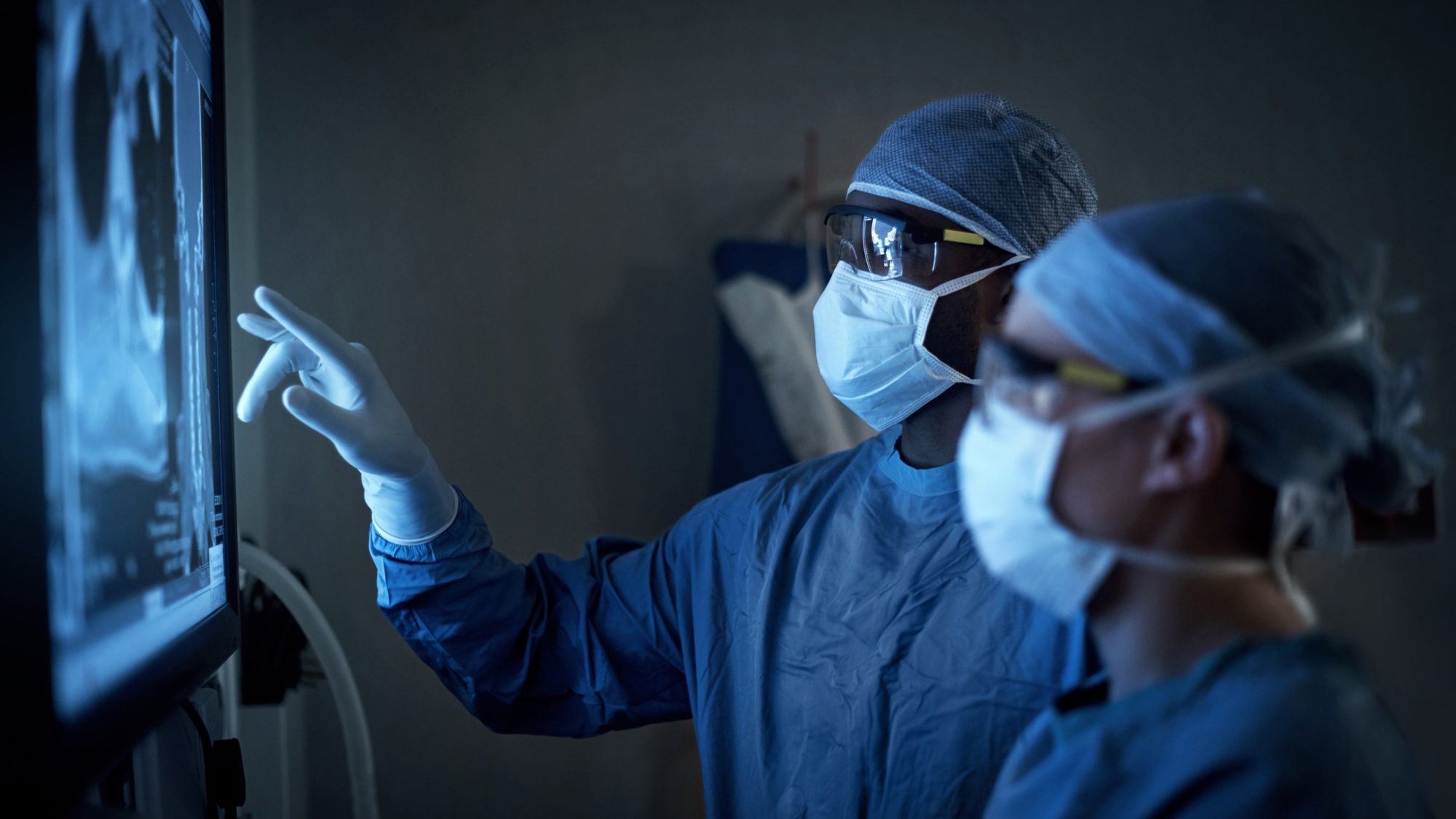
Spinal Cord Injury Symptoms
The symptoms of SCI can vary widely, depending on the severity and the location of the injury. The spinal cord sends messages from your brain to the rest of your body and vice versa, so an injury can disrupt this communication.
Some common symptoms that people may experience are:
- Loss of Movement: You might find it challenging to move specific parts of your body, especially below the level of the injury. Symptoms can range from a weakening of muscle strength to complete paralysis.
- Altered Sensation: You may notice changes in how you feel touch, temperature, or pain. Some areas below the injury might feel numb or have a decreased sensitivity to stimuli.
- Pain or Discomfort: Some individuals experience pain or an intense stinging sensation from the damage to nerve fibers in the spinal cord. This can include neuropathic pain, which feels like burning, tingling, or shooting pains.
- Reduced Control over Bladder and Bowel Functions: The injury might affect your ability to control your bladder and bowels, leading to incontinence or the need for alternative methods to manage these functions.
- Changes in Sexual Function: Depending on your injury, you might experience changes in sexual function, sensitivity, or fertility. These changes can affect men and women and involve physical and emotional adjustments.
- Difficulty Breathing or Coughing: If the injury is in the upper part of your spinal cord, it might affect the muscles that control breathing or coughing, making these actions more difficult.
- Spasms or Increased Reflex Actions: You might notice involuntary movements or exaggerated reflexes below the level of the injury.
Every person’s experience with SCI is unique, and your symptoms can change over time, especially during the early stages of recovery and rehabilitation. The goal of your care team is to manage these symptoms effectively, improving your comfort and quality of life.
Management strategies include medication, physical therapy, use of assistive devices, and sometimes surgery, depending on your specific symptoms and needs.
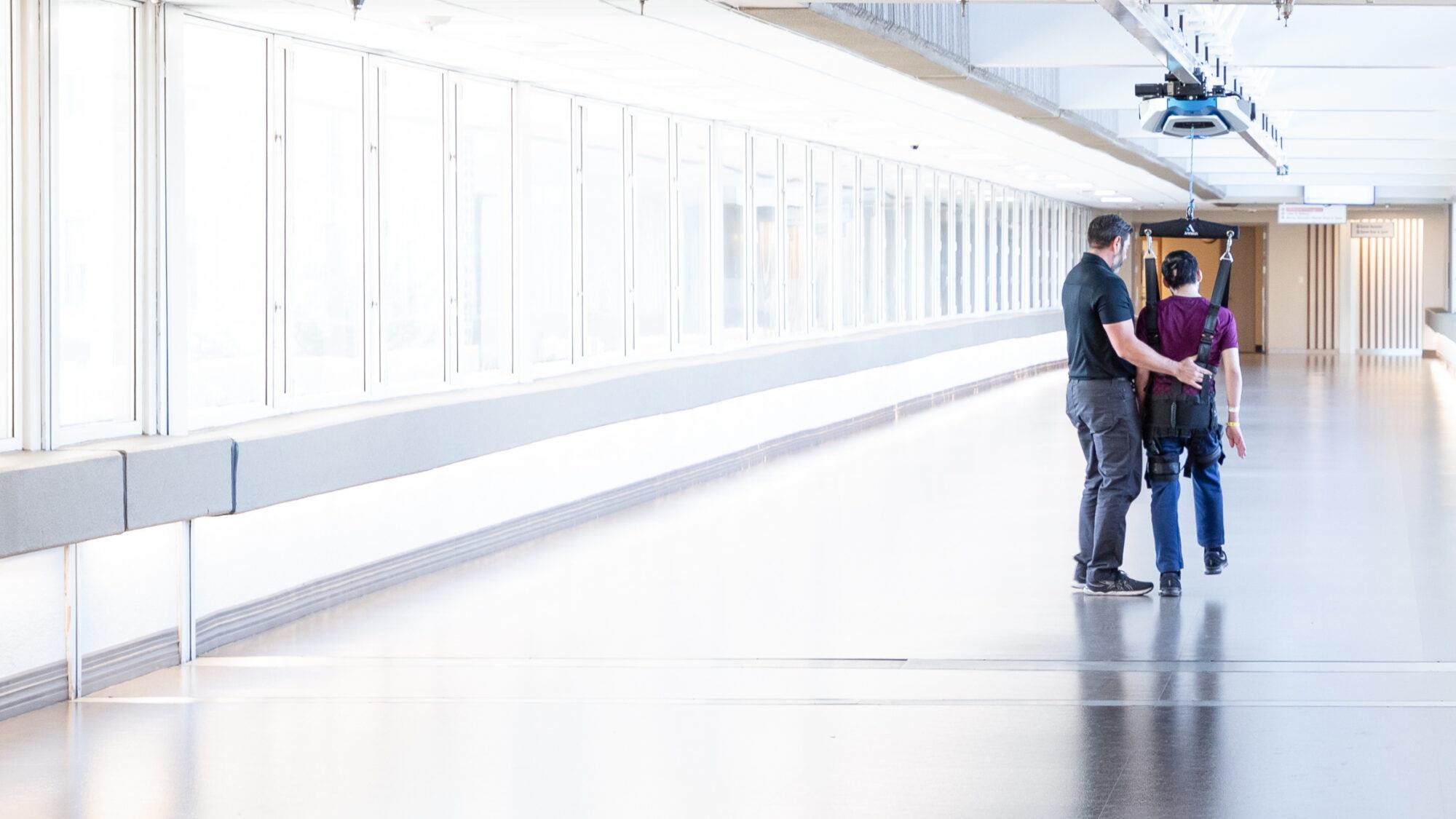
Treatments for Spinal Cord Injury
Spinal cord injury treatments vary depending on your injury, including its location and severity. While there’s currently no way to reverse damage to the spinal cord, there are many treatments aimed at minimizing further injury, reducing complications, and helping you live as independently as possible.
Here’s an overview of the types of treatments that may be available:
- Immediate Care: Right after the injury, the focus is stabilizing your vital signs, preventing shock, and ensuring you can breathe. Use of a ventilator may be necessary if your breathing is affected.
- Surgery: In some cases, surgery is necessary to remove fragments of bones, foreign objects, herniated disks, or fractured vertebrae that are compressing the spine. Surgery can also help stabilize the spine to prevent future pain or deformity.
- Medication: Some medications can help manage symptoms or improve outcomes. For example, your doctor may give you corticosteroid drugs shortly after the injury to reduce inflammation and prevent further damage. Other medications can help manage pain, bladder and bowel control, and muscle spasticity.
- Rehabilitation: Rehabilitation therapy is a cornerstone of SCI treatment. A team of specialists, including physical medicine and rehabilitation physicians, physical therapists, occupational therapists, and rehabilitation nurses, will work with you to:
- Develop strength and flexibility
- Learn new techniques to accomplish daily tasks
- Use assistive devices if needed
- Adapt to changes in sexual function and manage fertility issues
- Ongoing Care: Managing your health after an SCI involves regular check-ups and monitoring to prevent complications such as pressure sores, urinary tract infections, or blood clots. It also includes maintaining a healthy lifestyle, a balanced diet, and regular exercise adapted to your abilities.
- Psychological Support: Adjusting to life after an SCI can be challenging, not just physically but emotionally and socially. Support from psychologists, counselors, or peer support groups can be invaluable in helping you and your loved ones adapt to these changes.
- Emerging Treatments: Research on spinal cord injury is ongoing, and new treatments are being developed. This includes advanced technologies like electrical stimulation devices, robotics, and potential biological treatments like stem cell therapy, which aim to restore some function or improve mobility.
The goal is to tailor a treatment plan that fits your specific needs and objectives, focusing on enhancing your independence and overall quality of life. We’re here to support you through every step of your journey, from acute care to long-term management and rehabilitation.
Neuro-Rehabilitation for Spinal Cord Injury
Spinal cord injury rehabilitation is a critical process designed to help you achieve the highest possible level of independence and quality of life after your injury. It’s a personalized program that begins soon after your injury and can continue for months or even years, depending on your specific needs. Here’s a brief overview of what it involves:
- Physical Therapy: Aims to strengthen your muscles, improve mobility, and increase flexibility. It’s about helping you move as effectively as possible, whether that’s walking, using a wheelchair, or performing daily tasks with more ease.
- Occupational Therapy: Focuses on everyday activities, from dressing and bathing to using technology and cooking. The goal is to help you adapt to your injury and regain as much independence as possible.
- Speech and Language Therapy: If your injury affects your ability to speak or swallow, this therapy helps you regain these skills or learn new communication methods.
- Psychological Support: Adjusting to life after a spinal cord injury can be challenging. Counseling or therapy can provide emotional support and help you develop coping strategies.
- Education: Learning about your injury, how to prevent complications, and how to manage your health, including how to use any medications or equipment you may need, is crucial to rehabilitation.
- Vocational Rehabilitation: If you plan to return to work, vocational rehabilitation can help you identify suitable employment and may offer training for new skills.
- Adaptive Technologies and Equipment: Wheelchairs, voice-activated computers, and other devices can help you maintain independence and improve your quality of life.
Your rehabilitation team will work closely with you and your family to create a plan tailored to your goals and needs. It’s a collaborative effort aimed at helping you adapt to changes, overcome challenges, and lead a fulfilling life post-injury.
Common Questions about Spinal Cord Injury
Can you recover from a spinal cord injury?
Recovery from a spinal cord injury (SCI) varies significantly based on the location and severity of your injury, as well as your overall health and the timeliness and quality of medical care and rehabilitation you receive.
Complete vs. Incomplete Injuries
Complete SCI means no sensory or motor function is preserved below the injury level. Recovery prospects in regaining function are generally limited. However, rehabilitation can still improve independence and quality of life.
Incomplete SCI means some neurological function is retained below the injury level. You have a better chance of regaining some function if your injury is incomplete. Still, the range of recovery can vary widely.
Factors Influencing Recovery
Immediate treatment following an SCI can help reduce swelling and minimize further damage to your spinal cord, potentially improving your outcome.
In the longer term, engaging in a comprehensive rehabilitation program is crucial. Physical therapy, occupational therapy, and other forms of rehabilitation, such as return to work or school programs, can maximize recovery by improving physical function, strength, and independence.
Emotional and social support from your family, friends, and peer support groups can significantly impact your motivation and psychological well-being during the recovery and rehabilitation process.
Looking to the future, medical research initiatives such as neuroregenerative techniques, stem cell therapy, and neurostimulation, are exploring new ways to repair spinal cord damage and restore function. While these treatments are still being developed, they offer hope for future recovery possibilities.
Reality of Recovery
While some individuals may experience significant improvements and regain function, it’s essential to understand that a complete recovery—meaning a total return to pre-injury function—is rare. Most people with SCI will experience some permanent changes in their physical capabilities. However, you can still lead an active, fulfilling life with the proper support and rehabilitation.
Adjusting your expectations and focusing on achievable goals, such as increasing independence, learning new skills, and adapting to new ways of living, are critical components of the recovery process. It’s also essential to stay informed about new treatments and technologies that may improve recovery outcomes in the future.
How long is the hospital stay for a spinal cord injury?
It takes time and personal knowledge of your circumstances to answer this question accurately. Still, a broad estimate for the initial hospital stay (acute care plus initial rehabilitation) can range from a few weeks to a few months. The total duration of your inpatient rehabilitation might average from one to three months, but this is highly individual. You and your family will want to discuss the expected timeline and goals with your healthcare team, as personalized plans based on your needs and progress will offer the most accurate projection of your hospital stay and overall recovery journey.
Additional Resources
References
- Brannigan JFM, Davies BM, Mowforth OD, Yurac R, Kumar V, Dejaegher J, Zamorano JJ, Murphy RKJ, Tripathi M, Anderson DB, Harrop J, Molliqaj G, Wynne-Jones G, Arbatin JJF, Kato S, Ito M, Wilson J, Romelean R, Dea N, Graves D, Tessitore E, Martin AR, Nouri A. Management of mild degenerative cervical myelopathy and asymptomatic spinal cord compression: an international survey. Spinal Cord. 2024 Feb;62(2):51-58. doi: 10.1038/s41393-023-00945-8. Epub 2023 Dec 21. PMID: 38129661; PMCID: PMC10853067.
- Vedantam A, Jimsheleishvili G, Harrop JS, Alberga LR, Ahmad FU, Murphy RK, Jackson JB 3rd, Rodgers RB, Levi AD. A prospective multi-center study comparing the complication profile of modest systemic hypothermia versus normothermia for acute cervical spinal cord injury. Spinal Cord. 2022 Jun;60(6):510-515. doi: 10.1038/s41393-021-00747-w. Epub 2022 Jan 10. PMID: 35013548.
- Hawasli AH, Rutlin J, Roland JL, Murphy RKJ, Song SK, Leuthardt EC, Shimony JS, Ray WZ. Spinal Cord Injury Disrupts Resting-State Networks in the Human Brain. J Neurotrauma. 2018 Mar 15;35(6):864-873. doi: 10.1089/neu.2017.5212. Epub 2018 Jan 11. PMID: 29179629; PMCID: PMC5863102.
- Sun P, Murphy RK, Gamble P, George A, Song SK, Ray WZ. Diffusion Assessment of Cortical Changes, Induced by Traumatic Spinal Cord Injury. Brain Sci. 2017 Feb 17;7(2):21. doi: 10.3390/brainsci7020021. PMID: 28218643; PMCID: PMC5332964.



